

Pentagon Lifts Veil on 7 New Obscure Chinese Weapons. L'armée chinoise se dévoile - CHINE. Publié le : 17/04/2013 - 17:54Modifié le : 17/04/2013 - 19:48 Pékin a publié mardi 16 avril son huitième livre blanc de la défense.

Pour la première fois, le régime détaille ses effectifs militaires. Un exercice de transparence inédit destiné aussi bien aux puissances étrangères qu'aux Chinois. Jusqu'à présent, Pékin n'était pas connu pour étaler au grand jour les détails de sa force de frappe militaire. Mais un livre blanc de la défense, publié par la Chine mardi 16 avril, vient apporter des éclaircissements inédits sur le fonctionnement, la structure et le rôle de l’armée de la deuxième puissance mondiale.
PLAAF : People's Liberation Army Air Force. Chinese Man Steals Secret Military Data. Flash Eco : Chine: 5e exportateur mondial d'armes - Pale Moon. La Chine a dépassé la Grande-Bretagne pour devenir le cinquième exportateur d'armes avec 5% du commerce mondial de ce secteur, selon un rapport publié aujourd'hui par l'Institut international de recherche sur la paix de Stockholm (Sipri).
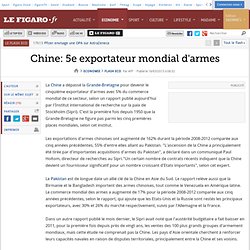
C'est la première fois depuis 1950 que la Grande-Bretagne ne figure pas parmi les cinq premières places mondiales, selon cet institut. New SIPRI Report Highlights China’s Export Rise. TAIPEI — A new report by the Stockholm International Peace Research Institute (SIPRI), “Trends in International Arms Transfers, 2012,” indicates that China has displaced the United Kingdom as the world’s fifth-largest exporter of major conventional arms.
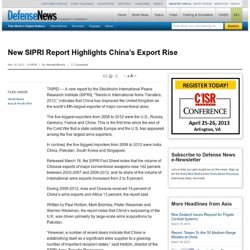
The five biggest exporters from 2008 to 2012 were the U.S., Russia, Germany, France and China. This is the first time since the end of the Cold War that a state outside Europe and the U.S. has appeared among the five largest arms exporters. In contrast, the five biggest importers from 2008 to 2012 were India, China, Pakistan, South Korea and Singapore. Released March 18, the SIPRI Fact Sheet notes that the volume of Chinese exports of major conventional weapons rose 162 percent between 2003-2007 and 2008-2012, and its share of the volume of international arms exports increased from 2 to 5 percent.
During 2008-2012, Asia and Oceania received 74 percent of China’s arms exports and Africa 13 percent, the report said.
What a war between China and the US would look like. China boosts defence budget 11 percent after U.S. pivot. Chinese navy. Military and Security Developments Involving the People’s Republic of China - 2011. Pictures From China's 62nd National Day - Damien Ma - International. Instead of wasting words on this year's annual Communist Party celebration that leads into the "Golden Week" of unbridled consumerism, I must share some photos that will say everything and more.
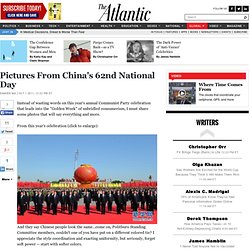
From this year's celebration (click to enlarge): And they say Chinese people look the same...come on, Politburo Standing Committee members, couldn't one of you have put on a different colored tie? I appreciate the style coordination and exacting uniformity, but seriously, forget soft power -- start with softer colors. Now, for contrast, sixty years earlier: Nope, this is not DC Gay Pride 2011, but apparently the CCP National Day parade in...wait for it...1950!
China’s Long-Anticipated Defense White Paper Disappoints. By Bonnie Glaser After a three month delay, the Chinese Ministry of Defense released its National Defense White Paper for the year 2010.
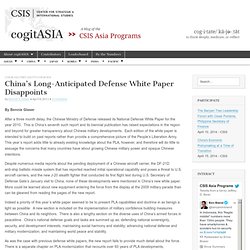
This is China’s seventh such report and its biennial publication has raised expectations in the region and beyond for greater transparency about Chinese military developments. Each edition of the white paper is intended to build on past reports rather than provide a comprehensive picture of the People’s Liberation Army. This year’s report adds little to already existing knowledge about the PLA, however, and therefore will do little to assuage the concerns that many countries have about growing Chinese military power and opaque Chinese intentions. Indeed a priority of this year’s white paper seemed to be to present PLA capabilities and doctrine in as benign a light as possible.
As was the case with previous defense white papers, the new report fails to provide much detail about the force. Bonnie S. Bonnie S. 2011: Year of the PLA? For Asia Pacific governments and other observers of the Chinese military, the Christmas season was anything but quiet.

The future of warfare. Alight-bulb moment for me last year was hearing a Chinese defense expert named Dingli Shen in Shanghai talk about the future of warfare.
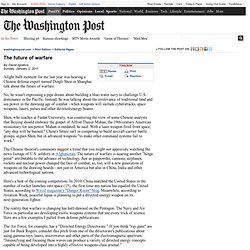
No, he wasn't expressing a pipe dream about building a blue-water navy to challenge U.S. dominance in the Pacific. Instead, he was talking about the irrelevance of traditional land and sea power in the dawning age of combat - when weapons will include cyberattacks, space weapons, lasers, pulses and other directed-energy beams. Shen, who teaches at Fudan University, was countering the view of some Chinese analysts that Beijing should embrace the gospel of Alfred Thayer Mahan, the 19th-century American missionary for sea power. Mahan is outdated, he said: With a laser weapon fired from space, "any ship will be burned. " La Chine et sa nouvelle posture diplomatico-militaire. Mark Stokes and Dan Blumenthal - Why China's missiles should be our focus. With the New START treaty ratified, the Obama administration can turn its attention to the real source of nuclear instability among the great powers: China's buildup of conventional ballistic missiles.
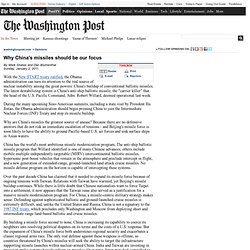
The latest destabilizing system is China's anti-ship ballistic missile, the "carrier killer" that the head of the U.S. Pacific Command, Adm. Robert Willard, deemed operational last week. During the many upcoming Sino-American summits, including a state visit by President Hu Jintao, the Obama administration should begin pressing China to join the Intermediate Nuclear Forces (INF) Treaty and stop its missile buildup. Are U.S. Defense Experts Getting China Wrong? TAIPEI — Are Western experts on China’s military modernization efforts misreading and downplaying the level of ambition, sophistication and just plain guts the Chinese are showing in the country’s quest to be a top arms player?
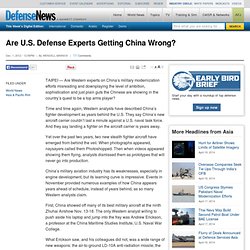
Time and time again, Western analysts have described China’s fighter development as years behind the U.S. They say China’s new aircraft carrier couldn’t last a minute against a U.S. naval task force. And they say landing a fighter on the aircraft carrier is years away. Yet over the past two years, two new stealth fighter aircraft have emerged from behind the veil.
When photographs appeared, naysayers called them Photoshopped. China’s military aviation industry has its weaknesses, especially in engine development, but its learning curve is impressive. First, China showed off many of its best military aircraft at the ninth Zhuhai Airshow Nov. 13-18. STRATCOM Commander Rejects High Estimates for Chinese Nuclear Arsenal » FAS Strategic Security Blog. .
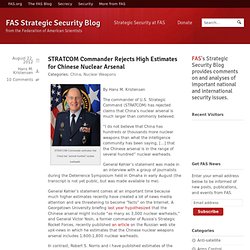
By Hans M. Kristensen The commander of U.S. Strategic Command (STRATCOM) has rejected claims that China’s nuclear arsenal is much larger than commonly believed. Philippines and China to sign first military deal. 7 December 2010Last updated at 05:39 By Kate McGeown BBC News, Manila The Philippines is fighting long-running insurgencies with both Communist and Islamic rebels The Philippines, one of America's staunchest allies in South-East Asia, is due to agree a deal with China to supply it with military hardware. The head of the Philippine armed forces is in Beijing to sign what has been described as a "very substantial" agreement. A military spokesman denied that the move marked a shift in alliance from the US to China. But this is seen as another sign of China's expanding reach in the region.
The Philippines has one of the weakest militaries in East Asia, and is fighting long-running insurgencies with both Communist and Islamic rebels. It urgently needs equipment - a key part of its current stock is made up of second-hand assault rifles, boats and aircraft from the United States. American forces are also based in the country to help train local soldiers.